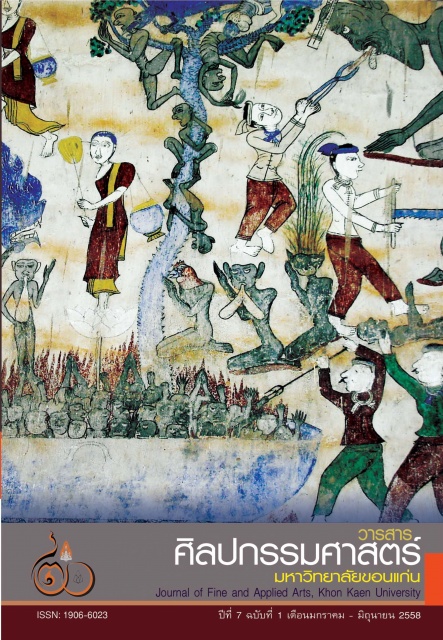อัตลักษณ์และการดำรงอยู่ของดนตรีและรำวงคองกา กรณีศึกษาอำเภอโพธิ์ชัย จังหวัดร้อยเอ็ด TRADITIONAL THAI CONGA DANCE AND MUSIC: A CASE STUDY OF KHAMPHA-UNG SUBDISTRICT, POCHAI DISTRICT, ROI-ED PROVINCE, THAILAND
Main Article Content
Abstract
การวิจัยเรื่อง อัตลักษณ์และการดำรงอยู่ของรำวงคองกา กรณีศึกษา อำเภอโพธิ์ชัย จังหวัดร้อยเอ็ด โดยมีวัตถุประสงค์ เพื่อศึกษาประวัติ การสืบทอดและการดำรงอยู่ และ ลักษณะของดนตรีและบทเพลงประกอบการแสดงของรำวงคองกา ผู้วิจัยได้ใช้ระเบียบวิธีการวิจัยทางมานุษยดนตรีวิทยา เก็บข้อมูลจากชาวบ้านที่เป็นนักแสดง และ นักดนตรี
ผลการศึกษาพบว่า การละเล่นรำวงคองกาเป็นการละเล่นเพื่อความบันเทิงของชาวบ้าน มีพัฒนาการมาจากรำโทน ซึ่งเป็นการเล่นพื้นเมืองของชาวไทย ที่นิยมเล่นกันเฉพาะฤดูกาลตามท้องถิ่น มีการสร้างสรรค์ท่าทางการรำและบทร้อง โดยสันนิษฐานการเรียกชื่อการแสดงลักษณะนี้มีที่มาจากความหมายที่ใช้ในการเรียกชื่อตามจังหวะที่ใช้ในการแสดง และการเรียกชื่อตามกิจกรรมที่ชาวนาได้นำต้นกล้ามากองรวมกันเพื่อการแสดงเพื่อขอฝน โดยเรียกว่า “รำวงกองกา” การละเล่นรำวงคองกา มีการสืบทอดแบบปากต่อปาก รุ่นสู่รุ่น ส่วนมากการเรียนรู้เกิดขึ้นภายในครอบครัว แล้วจึงขยายออกสู่ภายนอก ไม่มีการจดบันทึกเป็นหลักฐาน พบว่าเป็นกิจกรรมที่ให้ความสนุกสนาน สร้างความสามัคคีกลมเกลียวกันในชุมชน มีความสัมพันธ์กับประเพณีฮีตสิบสองคลองสิบสี่ ซึ่งเป็นวิถีชีวิตของคนในภูมิภาคอีสาน เครื่องดนตรีที่ใช้บรรเลงประกอบด้วย กลอง ฉิ่ง ฉาบ ลูกแซ็ก นกหวีด และ แทมบูรีน การรำวงคองกาจัดเป็นวงรำกันเป็นคู่หญิง ชาย มีการรำท่าที่เป็นเอกลักษณ์ของรำวงคองกา คือการยักไหล่ไปตาม การบรรเลงดนตรี กลองบรรเลงต่อเนื่องกันไปเรื่อยๆ ต่อเนื่องหลายเพลง นักร้องจะใช้ไหวพริบปฏิภาณและความชำนาญในการร้อง ลักษณะการดำเนินทำนองใช้บันไดเสียงเพนทาโทนิค มีการซ้ำทำนองและเนื้อร้องอยู่บ่อยๆ ลักษณะเนื้อเพลงสะท้อนให้เห็นถึงชีวิตความเป็นอยู่ที่เรียบง่ายในชุมชน
This research is about characteristics and the surviving continuity of Konga Dance within the Pochai district Roi-ed province community, in Northeast Thailand. This study focuses on the history and the passing on of the music and musical accompaniment of the Konga Dance. Data for this research came from formal and informal interviews and first hand observations.
The research found that the Konga Dance and its music is performed for entertainment developing from Rum Tone, a traditional Thai Dance. Rum Tone is usually performed only during specific localized seasons. The lyrics and dance movements are creative. The name “Konga” comes from the rhythm used in the accompanying music as well as from the ceremony’s name. This is a rain ceremony where farmers bring small rice plants and put them all together to ask for rain. The dancing in the ceremony is called “Rumwong Konga”.
The Konga Dance and its music are passed on orally from generation to generation. Most learning happens within the families that practice the dance and has slowly expanded to outside of the family structure available to the greater public, despite there being no written documentation to pass on the lyrics or style of the dance. In contemporary performance the dance has remnants of traditional beliefs but most of the time it is performed for entertainment, creating social harmony, relative with the traditional Heat 12 Klong 14 which the way of life that Isan (Northeast Thailand) people live . There is a Wai Kru ceremony, a ceremony where students pay respect to their teachers, before the performance. The accompaniment music for the Konga Dance uses drums, finger cymbals, cymbals, shaker, whistle and tambourine. The Konga dance is a couple’s dance between women and men. The most prominent characteristic of Konga dance is moving the shoulders along with the music. The number of performers can vary from small for more intimate gatherings to large for bigger occasions. The drumming will continue without stopping and the singer will have to use improvisatory skills to transition from one song to another. The music uses pentatonic scales and often has melodic and lyric repetition. Usually the lyrics are about simple living and life in Isan.
Article Details
Content and information in articles published in the Journal of Fine and Applied Arts of Khon Kaen University is regarded as the opinion and sole responsibility of the author(s) directly; therefore, editors are not obliged to agree to or share any responsibility with regard to the content and information that appears within these articles.
All articles, information, content, image, etc. that have been published in the Journal of Fine and Applied Arts of Khon Kaen University is the copyright of the Journal of Fine and Appllied Arts of Khon Kaen University. Any person or organization who wishes to distribute all or parts of the articles for further dissemination or other usage must first receive permission from the Journal of Fine and Applied Arts of Khon Kaen University before proceeding to do so.


